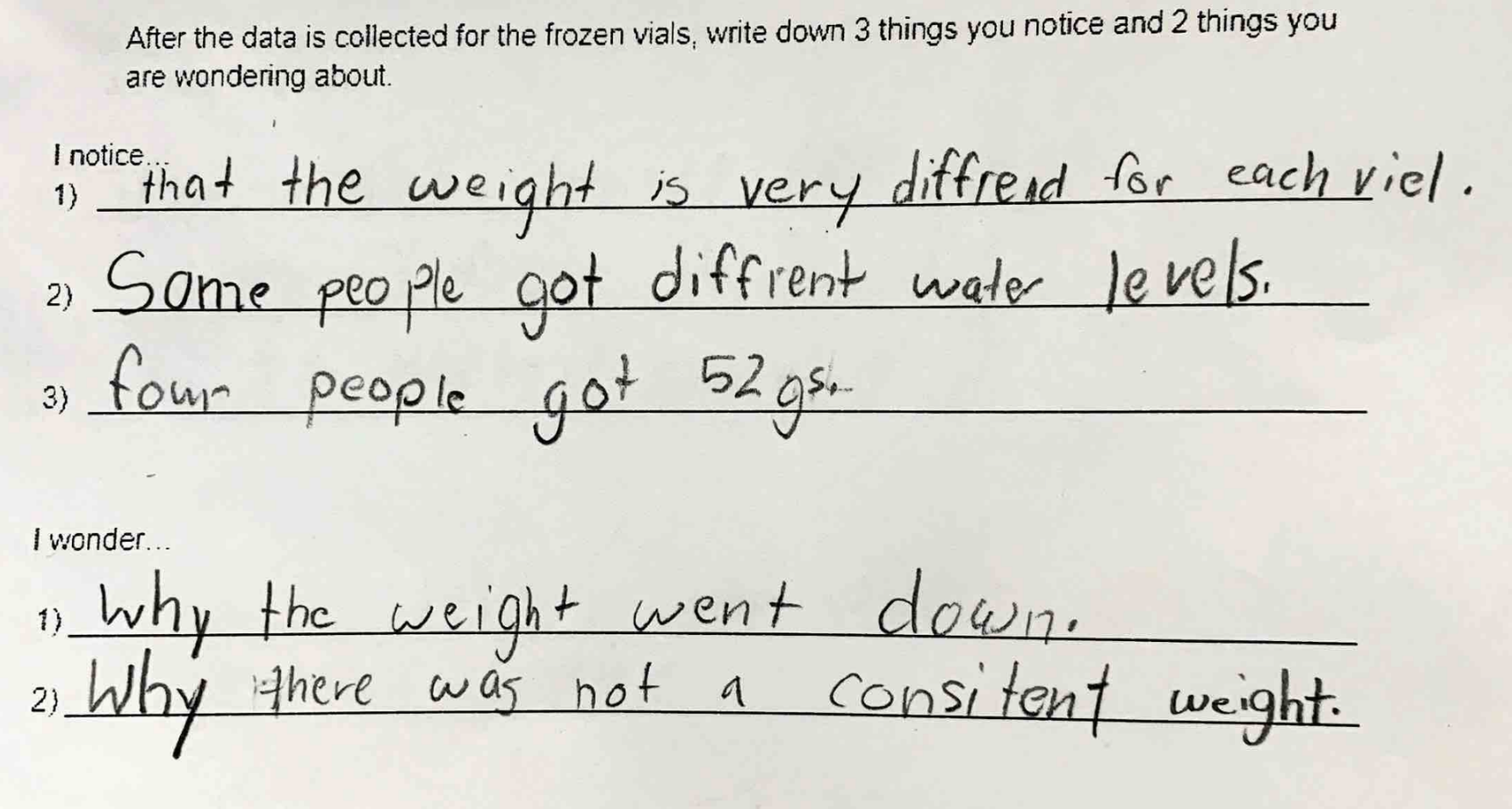Conservation of Matter Investigation
In this fifth-grade investigation, students explore the phenomenon of a glass bottle of water breaking when it is left out over night at freezing temperatures. They wonder why the bottle breaks, using models to develop explanations of what is happening to water molecules in the bottle. They wonder if the water is expanding, then do an investigation to test whether the volume and weight of water change as it freezes. The results help them develop an understanding of the conservation of matter.
Context
The investigation takes place during a unit on the structure and properties of matter. Before this investigation, students have learned that matter is composed of particles (molecules). They have explored what happens to particles at different temperatures and have been drawing, sharing, and revising models as part of their science work.
Authors: This investigation was developed with support from Lindsay Weaver and Sam Patton (Somerville Public Schools).
Click images to expand
NGSS Standards
5-PS1-1: Develop a model to describe that matter is made of particles too small to be seen.
5-PS1-2: Measure and graph quantities to provide evidence that regardless of the type of change that occurs when heating, cooling, or mixing substances, the total weight of matter is conserved.
Forms of Uncertainty
Among other uncertainties, students in these lessons are supported to engage with:
How to define attributes: Students think about water getting bigger, and differentiate "bigness" into different attributes (such as water level, volume, and weight). They consider how these are different but related.
How to organize and represent data: Students consider how to represent the weights of their individual vials of water before and after freezing in order to conclude what happened to most of the vials. They consider different representations, discussing what each makes it easy to see and what each hides.
How to make sense of variability: Students look at the weights of their vials before freezing them, wondering why they are different weights. After freezing, they find that some of the vials increased in weight, many stayed the same, and some decreased in weight. They consider why this might be and discuss whether and how they can draw a conclusion from data with variability.
How to identify mechanisms: After agreeing that as water freezes it expands but stays the same weight, students are still uncertain about how this could happen. They discuss and use new resources such as a simulation to help them make progress on this new puzzle.
Explore the full Uncertainty Overview for this investigation to learn more about these and the other forms of uncertainty that students engage with in this investigation.
What Happens in This Investigation?
Engaging with the Phenomenon
Students engage with the phenomenon of a bottle breaking as water freezes. They draw models to explain their ideas of how this could happen. They share and compare models, recognizing that they have different ideas about what is happening inside the bottle and posing questions about water expansion that can guide investigation.
Explore related forms of uncertainty, instructional materials, and tools.
Conservation of Matter Investigation Overview
Lesson 1: Why does the glass bottle break when water freezes?
Planning and Conducting the Investigation
Students discuss how to design an investigation to see whether the weight and volume of water change as it freezes. Students set up the vials and make predictions about what will happen when they freeze them. They measure the weight and volume of each vial before and after freezing.
Explore related forms of uncertainty, instructional materials, and tools.
Lesson 2: What happens to the water level and weight of the water as it freezes?
Planning Investigations Conversation Tool
Supporting Claims with Evidence
Students combine their volume and weight data. They look across the data and can easily make and support a claim that the water level increases as water freezes, but the weight data is less conclusive. They represent the class’s weight data in different ways and work together to make a claim in light of variability.
Explore related forms of uncertainty, instructional materials, and tools.
How to organize and represent data
How to make sense of variability
How to move from individual cases to comparisons
Lesson 3: What can we claim based on the data from our investigation?
A data table showing the weight and water level of students’ vials before and after freezing.
Developing Explanations
Students return to their initial models to see whether they can explain findings from the investigation or whether they need to be revised. They pose new questions and puzzles. They use a simulation to understand what the water molecules do when they freeze and explore the law of conservation of matter. Students use these new resources to develop an explanation of how the bottle breaks.

